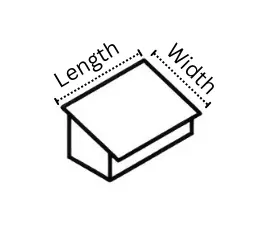Sloped Roof Area Calculator
Quickly estimate the surface area of your pitched roof based on dimensions and roof pitch. Perfect for roofing material and cost estimates.

A sloped roof (also called a pitched roof) has an angled surface, which means its surface area is larger than the building's footprint. If you're planning roofing, estimating material, or calculating costs, knowing the exact sloped roof area is crucial.
How to Calculate Sloped Roof Area?
You’ll need:
- Length of the building (L)
- Width of the building (W)
- Roof pitch (rise/run)
Step 1: Calculate Roof Slope Multiplier
The Roof Slope Multiplier accounts for the slope increase compared to the flat footprint.
Formula:
Step 2: Calculate Flat Roof Area
Multiply the Length and Width of the building.
Formula:
Step 3: Calculate Sloped Roof Area
Multiply the Flat Area by the Roof Slope Multiplier.
Formula:
Example Calculation
Let’s say:
- Length = 40 ft
- Width = 30 ft
- Roof pitch = 6:12 (Rise = 6 ft, Run = 12 ft)
Step 1: Calculate Multiplier
Step 2: Calculate Flat Area
Step 3: Calculate Sloped Roof Area
FAQs
1. Why is a sloped roof better than a flat roof?
Sloped roofs provide better drainage, reduce water leakage risks, and can handle heavy rain or snow more effectively compared to flat roofs.
2. How do I calculate the area of a sloped roof?
To calculate the sloped roof area, multiply the building’s footprint area by the pitch factor (a multiplier based on roof steepness).
3. What are common materials used for sloped roofs?
Popular materials include asphalt shingles, metal sheets, clay tiles, slate, and wood shingles.
4. What is roof pitch and why does it matter?
Roof pitch is the steepness or angle of a roof. It affects the roof’s ability to shed water, its structural design, and the type of materials suitable for installation.
5. Where Are Low Slope Roofs Most Common?
Low slope roofs are most common on commercial buildings, industrial warehouses, apartment complexes, and modern-style homes. They are also widely used in urban areas where space efficiency and easy rooftop access (for HVAC units or solar panels) are important.